

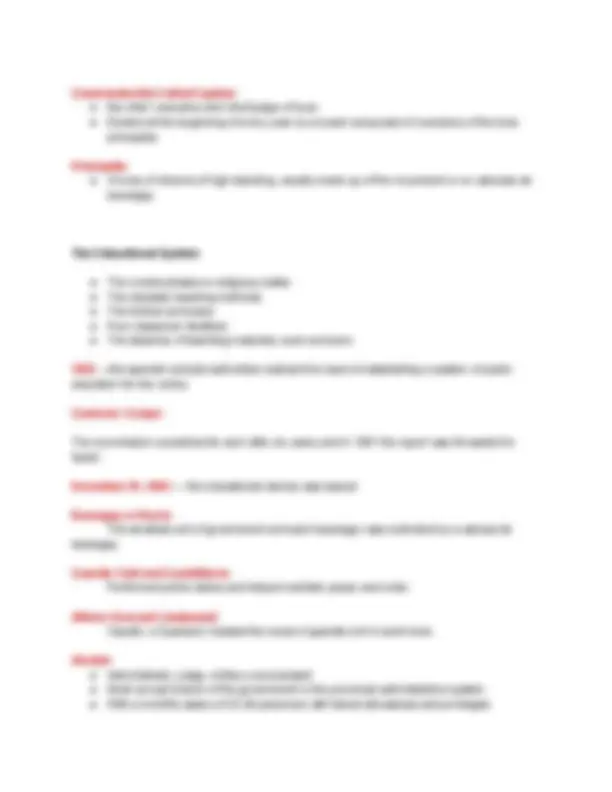
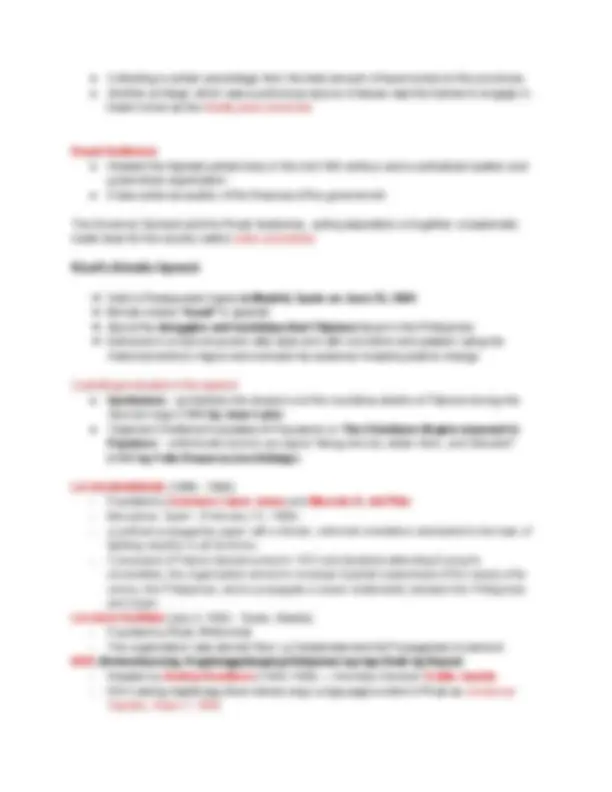
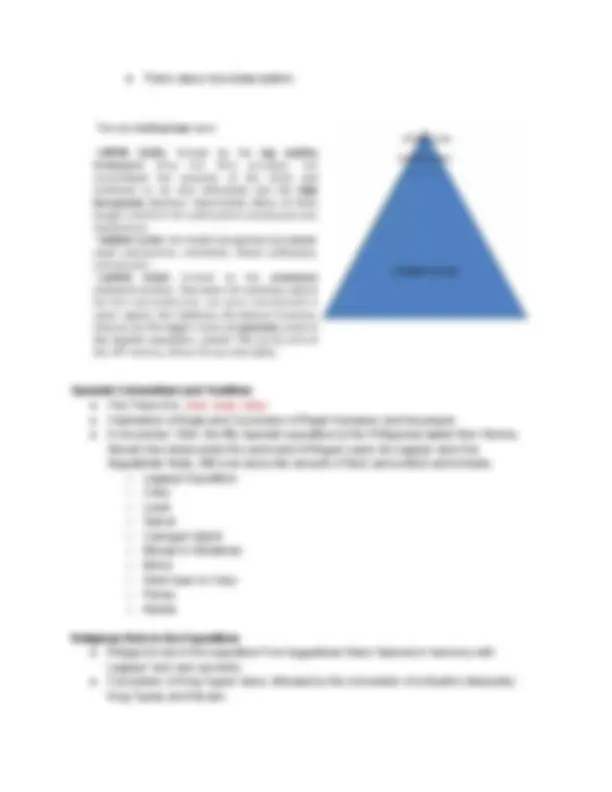
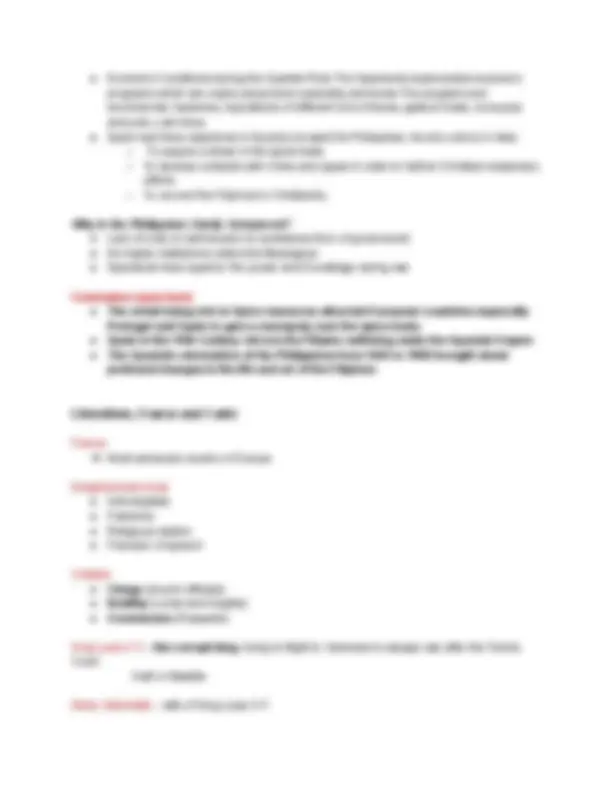
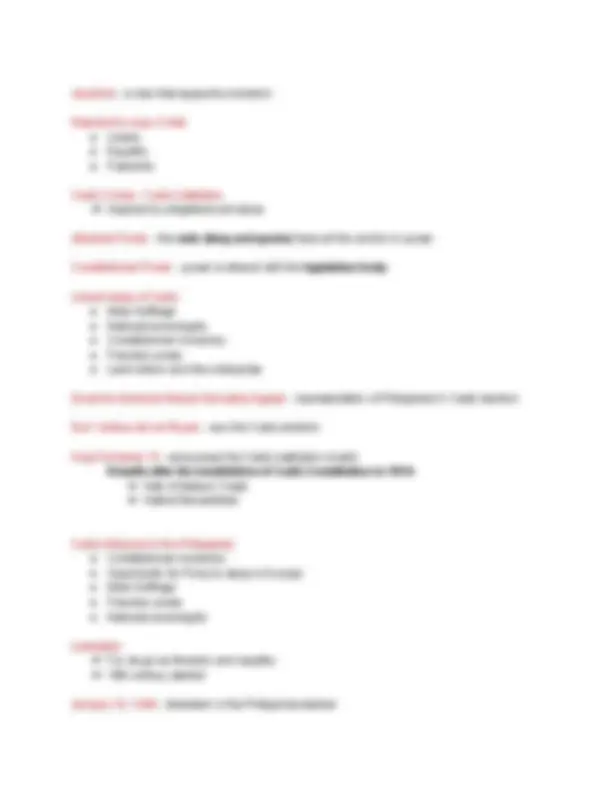
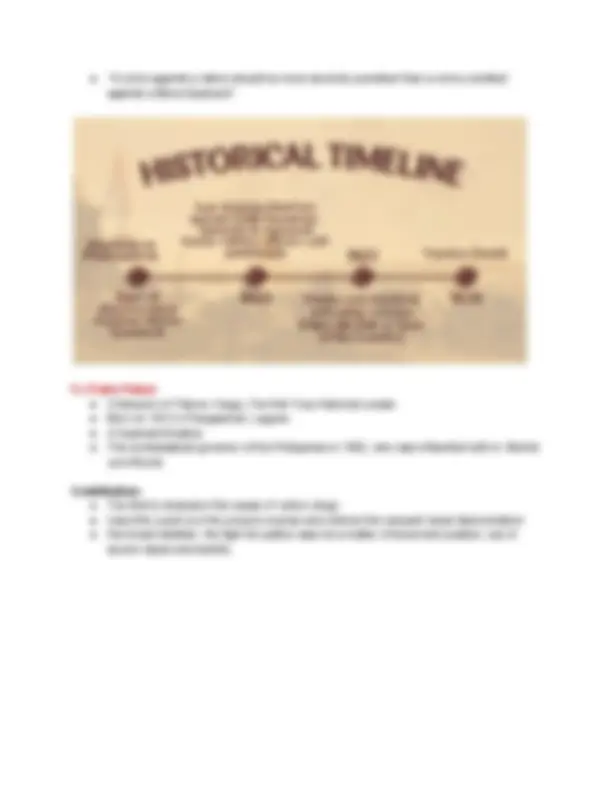

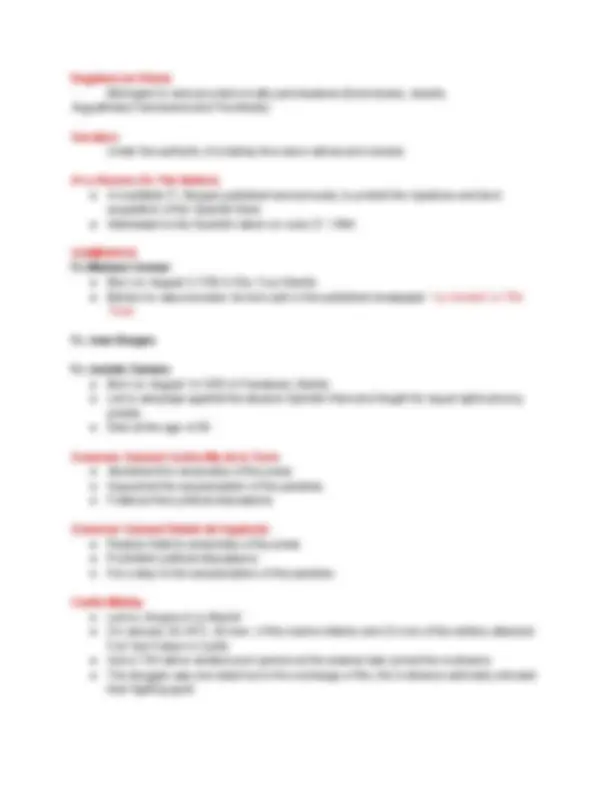


Study with the several resources on Docsity

Earn points by helping other students or get them with a premium plan


Prepare for your exams
Study with the several resources on Docsity

Earn points to download
Earn points by helping other students or get them with a premium plan
Community
Ask the community for help and clear up your study doubts
Discover the best universities in your country according to Docsity users
Free resources
Download our free guides on studying techniques, anxiety management strategies, and thesis advice from Docsity tutors
Study notes for Life and works of Rizal covering 4 topics
Typology: Study notes
1 / 17

This page cannot be seen from the preview
Don't miss anything!










GEC109 - Life and Works of Rizal Section: B1-1 Prof. Lyra Joy A. Collantes
● Sixty years after Jose RIzal was executed in Bagumbayan, the mere mention of his two novels, Noli Me Tangere (1887) and El Filibusterismo (1891) could still whip up bitter debates and controversies Don Claro M. Recto ● Firebrand of the senate and leading nationalist politicians ● Describes Rizal’s book as, “A constant and inspiring source of patriotism with which the minds of the youth, especially during their formative and decisive years in school, should be suffused. ● Authored a bill which made Rizal novels (the unexpurgated versions) compulsory reading for all colleges and universities in the Philippines. ● Sponsored by the Committee on Education headed by Senator Jose P. Laurel and supported by all senators with the exception of— ○ Francisco Rodrigo ○ Decoroso Rosales ○ Mariano Cuenco Vehemently opposed the bill were the: ● Catholic Hierarchy ● Catholic Action of the Philippines ● Congregation of Missions ● Knights of Columbus ● Catholic Teacher Guild ● And an array of sectarian organizations They were countered by: ● Veteranos de la Revolución ● Alagad ni Rizal ● Freemasons ● Knights of Rizal Fr. Jesus Cavanna ● Attempted to discredit the nationalist position with a peculiar numbers game. ● Could not even begin to understand Rizal ● Actively involved with the Retraction hoax Heading the Veteranos de la Revolución ● Emilio Aguinaldo , the President of the First Republic ○ Denounced the Filipino clergy for putting themselves “under the yoke of the old spanish friars, against whom the Filipinos of 1896 had risen in arms…(with) our blood spilled on the battles.”
○ Demanded the true separation of Church and State and said that Rizal’s novels were “banned by the Spanish authorities who had kept Filipinos Subjugated for more than 300 years under the guise of Christianity.” Sen. Domocao Alonto ● The voice of Mindanao ● Disclosed that Rizal’s books were the bible of the Indonesians during their struggle for independence, he attacked the hypocrisy of Filipinos who proclaimed Rizal as “their national hero but seem to despise what he had written.” Rep. Pedro Lopez ● Boasted that the Filipinos struggle for Independence started on Mactan Island when Lapu-Lapu, “refusing to yield to alien opposition, slew Magellan thus repelling Spanish aggression.” Catholic Bishops Conference of the Philippines ● Insisted that Rizal attacked “the possibility of miracles, purgatory, the craments, indulgences, prayers, disparaged the veneration of saints, images, relics, the Blessed Mother, and questioned papal authority. Worst, Rizal doubted God ‘s Omnipotence.” ● Bishop Rufino Santos of Manila explained their opposition to the “compulsory reading in their entirety of such books in any school where Catholic students may be affected.” Senator Jose P. Laurel ● Head of the Education Committee ● Modified Recto’s bill for exemptions for “reasons of religious belief” On June 12, 1956, Republic Act no. 1425 (Rizal) was finally passed. Thus the writings of Rizal, especially the unexpurgated versions of Noli Me Tangere and El Filibusterismo become compulsory for all the public and private schools in the Philippines.
Social Culture: ● Philippine society was Feudalistic ● Conquistadores - Spanish land holding system imposed ● “Master- slave” , a relationship spaniards exacted all forms of taxes and tributes, and drafted the natives for manual labor.
Governadorcillo Called Capitan ● the chief executive and chief judge of town ● Elected at the beginning of every year by a board composed of members of the town principalia Principalia ● A body of citizens of high standing, usually made up of the incumbent or ex cabezas de barangay. The Educational System ● The overemphasis on religious matter ● The obsolete teaching methods ● The limited curriculum ● Poor classroom facilities ● The absence of teaching materials, such as books 1855 — the spanish colonial authorities realized the need of establishing a system of public education for the indios. Governor Crespo The commission completed its work after six years and in 1861 the report was forwarded to Spain. December 20 ,1863 — the educational decree was issued Barangay or Barrio The smallest unit of government and each barangay was controlled by a cabeza de barangay. Guardia Civil and Cuadrilleros Performed police duties and helped maintain peace and order. Alferez (Second Lieutenant) Usually a Spaniard, headed the corps of guardia civil in each town. Alcalde ● Administrator, judge, military commandant ● Most corrupt branch of the government in the provincial administrative system ● With a monthly salary of 25.00 pesos but with liberal allowances and privileges.
● Collecting a certain percentage from the total amount of taxes levied on the provinces ● Another privilege which was a pernicious source of abuse was the license to engage in trade known as the indulto para comerciar Royal Audiencia ● Headed the highest judicial body in the mid-19th century and a centralized system and pyramidical organization ● It also acted as auditor of the finances of the government. The Governor General and the Royal Audiencia , acting separately or together, occasionally made laws for the country called autos acordados
➔ Held in Restaurante Ingles in Madrid, Spain on June 25, 1884 ➔ Brindis means “toast” in spanish ➔ About the struggles and hardships that Filipinos faced in the Philippines ➔ Delivered in a humorous and witty style and with conviction and passion using his rhetorical skills to inspire and motivate his audience towards positive change 2 paintings included in the speech ● Spoliarium - symbolizes the despair and the countless deaths of Filipinos during the Spanish reign (1884 by Juan Luna ) ● Virgenes Christiana Expuestas Al Populacho or The Christians Virgins exposed to Populace - unfortunate women as virgins "being led out, stolen from, and ridiculed". ( 1884 by Felix Resurreccion Hidalgo ) LA SOLIDARIDAD (1889 - 1895)
● Spain and Portugal’s rivalry is rooted in the ‘discoveries’ made by Spain and Portugal. ● Pope Alexander VI issued a bull in 1493 dividing the world into two. ● Treaty of Tordesillas -neatly divided the "New World" into land, resources, and people claimed by Spain and Portugal on June 7, 1494. ● Magellan Expedition ○ Consist of 5 ships; The Trinidad, The Concepcion, The Victoria, The Santiago and The San Antonio. IV. The Battle of Mactan ● The refusal of Lapu Lapu to recognize the King of Spain as his sovereign has ignited this battle. Spanish: Identity, Monarchy and Empire I. Spain in the Enlightenment Period ● Spanish identity began during the Enlightenment ● The Enlightenment in Spain sought the expansion of scientific knowledge ● Values of liberty, constitutionalism, and co-existence had defined the various kingdoms of Spain II. Spain in the 19th Century ● The French Revolution under the ruling of Napoleon Bonaparte has given birth to the War of Independence ● A series of revolutions began and by the end of 1838, Cuba, Puerto Rico and the Philippines were Spain’s only remaining territories. ● The Constitution of 1812 ( Cadiz Constitution) was the most liberal constitution of its time and the first constitution in Spain. ● The Spanish Crown stands for Constitutional Monarchy ● Spain’s political instability can be traced back not only to the invasion of French but to their political shortcomings
● There was a new class system. Spanish Colonialism and Tradition ● The Three G’s: God, Gold, Glory ● Celebration of Mass and Conversion of Rajah Humabon and his people ● In November 1564, the fifty Spanish expedition to the Philippines sailed from Mexico. Aboard four ships under the command of Miguel Lopez de Legazpi were five Augustinian friars, 380 men and a fair amount of food, ammunition and trinkets. ○ Legazpi Expedition ○ Cebu ○ Leyte ○ Samar ○ Camiguin island ○ Butuan in Mindanao ○ Bohol ○ Went back to Cebu ○ Panay ○ Manila Religious Role in the Expedition ● Religion's role in the expedition Five Augustinian friars “labored in harmony with Legazpi” and won converts. ● Conversion of King Tupas’ niece, followed by the conversion of a Muslim Interpreter, King Tupas, and his son.
Jacobins - a club that supports revolution Napoleon's coup d’ etat ● Liberty ● Equality ● Fraternity Cadiz Cortes - Cadiz Institution ➔ Inspired by enlightenment ideas Absolute Power - the ruler (king and queen) have all the control or power Constitutional Power - power is shared with the legislative body Liberal Ideas of Cadiz ● Male Suffrage ● National sovereignty ● Constitutional monarchy ● Freedom press ● Land reform and free enterprise Governor-General Manuel Gonzales Aguilar - representation of Philippines in Cadiz election Don Ventura de los Reyes - won the Cadiz election King Fernando Vll - announced the Cadiz institution invalid Results after the invalidation of Cadiz Constitution in 1814: ➔ Halt of Galleon Trade ➔ Halted Mercantilism Cadiz Influence in the Philippines ● Constitutional monarchy ● Opportunity for Pinoy to study in Europe ● Male Suffrage ● Freedom press ● National sovereignty Liberalism ➔ For da go sa freedom and equality ➔ 18th century started January 19, 1946 - liberalism in the Philippines started
Gomburza Mariano Gom ez Jose Bur gos Jacinto Za mora (Base sa Lahi nga ppt) Liberalism — a political and moral philosophy based on the rights of the individual, liberty , consent of the government and equality before the law ➢ Father of Liberalism: John Locke General Carlos Maria de la Torre (abi nako’g Moira de la Torre hahaha) ● A fierce liberal, was appointed the Governor General in the Philippines ● He encouraged and open the discussion of political and social problems ● He abolished strict censorship of the press ● He encouraged Filipinos to speak out boldly for the political rights ● He openly affirmed his support of the Filipinization of the clergy and the secularization of the parishes held by the friars The Constitution of 1812 ● Known as Cadiz Constitution or Spanish Constitution of 1812 ● Was the 1st Spanish Constitution ● Signed on March 19, 1812 ● It is the result of Spain’s desire to end the abuse that results from the conservative system that exists in their country Liberal Ideas ➢ Freedom of the press ➢ Voting rights for all men over 25 ➢ Freedom of expression ➢ National sovereignty and ➢ A constitutional monarchy ➢ Ventura de los Reyes ➔ First Philippine legislator ➔ An ilocano who made his fortune in Manila as a merchant ➔ He represent the entire archipelago at the Spanish Parliament in Cadiz 1811 ➔ He was around 70 years of age The effect of the Cadiz Constitution on the Philippines: Galleon Trade Products from Acapulco, Mexico to Manila, Philippines and products from the Philippines to Mexico are traded.
● “A crime against a native should be more severely punished than a crime comitted against a fellow Spaniard” Fr. Pedro Palaez ● Champion of Filipino Clergy , The first Truly National Leader ● Born on 1812 in Pangasinan, Laguna ● A Spaniard Mestizo ● The ecclesiastical governor of the Philippines in 1862, who was influential both in Madrid and Manila Contribution: ● The first to champion the cause of native clergy ● Used the pulpit and the press to expose and criticize the rampant racial discrimination ● His broad idealism: the fight for justice was not a matter of blood and position, but of sound values and beliefs.
Father Jose Apolonio Burgos ● Born on February 9,1837 in the town of Vigan , Ilocos Sur ● Spanish Mestizo ● One of the three Filipino Martyr Priests collectively called GOMBURZA ● Brilliant student of Father Palaez at the University of Santo Tomas ● Openly and eagerly worked for clerical equality and for the secularization of parishes Secularization A movement within the Church seeking for the transfer of parishes from the regulars to secular priests
Death of GOMBURZA ● They were accused in the Cavite uprising. ● During their public execution (garrote) in Bagumbayan , on February 17 ,1872, the masses gathered to show their sympathy. ● On that day the racial classifications that labeled them as indios, insulares, chinos, christianos,etc. No longer mattered to them. GOMBURZA – served as an inspiration for Jose Rizal's historic work , El Filibusterismo. It marked the awakening of nationalist consciousness that led to the 1896 Philippine Revolution against Spain. Filipino Patriotism ● Enlightenment from ideas of Liberalism led people to not only question the government , but also think about what they deserved as a nation which is not oppression ● Natives grew a stronger attachment to their nation and a devotion to have their rights recognized and freedom given. Spanish Patriotism ● Creoles and Spanish mestizos advocated for justice and rights of the natives ● Fight against discrimination and oppression by the peninsulares or spanish authorities Virreinato de Nueva Espanya (New Spain) ● Mexico — capital Espanya Peninsula r — spanish nga ge panganak sa Spain Espanya Insular — spanish nga ge panganak sa Philippines
03-31-2023 Discussion Notes: 3 People who stated their notions on why the Spain colonized the Philippines: